Integrating Live, Virtual, Constructive Enablers: U.S. Army in Europe’s Ability to Create a Blended Training Environment
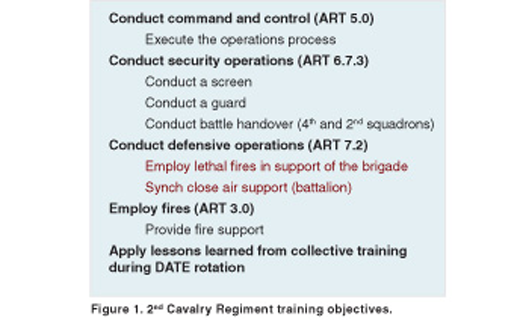
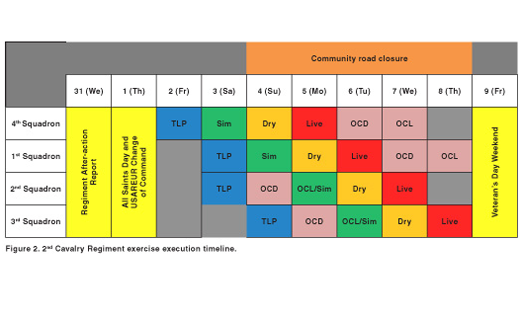
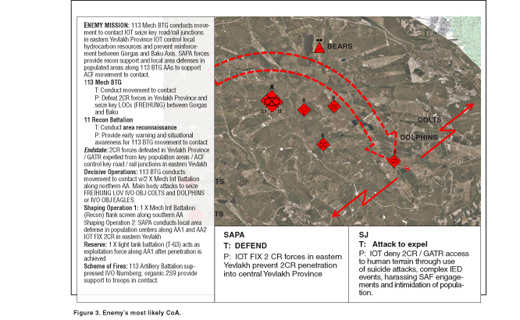
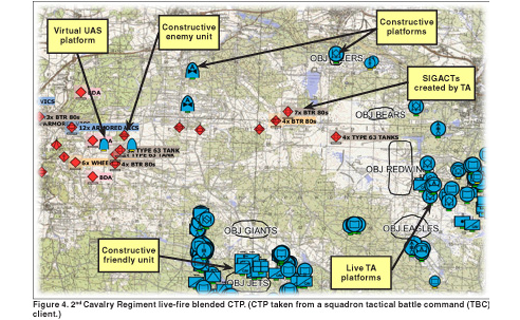
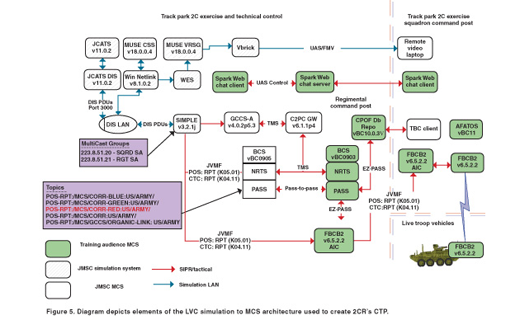

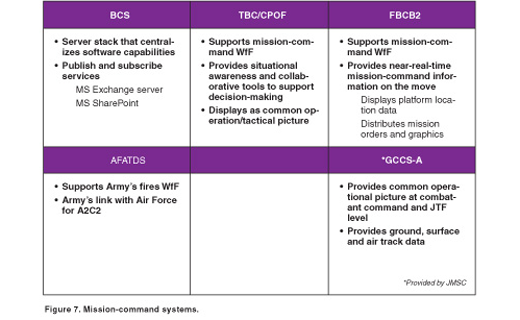
When U.S. Army Europe (USAREUR) conducted a unique squadron-level live-fire exercise (LFX) in support of 2nd Cavalry Regiment (CR) in November 2012, the LFX’s blended training environment combined live, virtual, constructive and gaming (LVC-G) training enablers to provide multi-echelon training from the individual Soldier to the squadron commander and staff. This blending of simulation with live training produced a one-of-a-kind training event that has implications for future training.
The LFX’s training environment was a temporary low-cost solution before USAREUR’s scheduled fielding of the live, virtual, constructive-integrating architecture (LVC-IA). Planners from 7th Army’s Joint Multinational Training Command (JMTC) in Grafenwoehr, Germany – which is USAREUR’s training command – designed the environment. JMTC planners also developed a scenario that replicated operational variables from the Caucasus Region in coordination with JMTC’s subordinate element, the Joint Multinational Readiness Center (JMRC), and 2CR planners. The scenario was a continuation of what 2CR experienced the month before during its decisive-action training environment (DATE) rotation at JMRC, the Army’s only overseas combat maneuver training center.
The 2CR LFX blended training environment addressed some home-station training concepts to help provide a more engaging and challenging training environment over traditional live-fire “gunnery” exercises. First, the creation of an expanded training environment in time and space allowed multi-echelon training and the ability to exercise squadron-level collective-training objectives that otherwise would not have been possible. Second, the LFX provided a consistent and reproducible training environment to exercise mission command. The LFX integrated and leveraged virtual, constructive and gaming capabilities of the Joint Multinational Simulation Center (JMSC) with the live capabilities of JMTC’s Grafenwoehr Range Operations to achieve this initial step toward an integrated architecture that the integrated training environment will bring.
So what was unique about the USAREUR LFX? Simply put, the LFX demonstrated the capability to leverage current LVC-G capabilities into a synchronized exercise environment to support the integration of multiple echelons above the individual Soldier through the battalion command-post (CP) level, which becomes extremely important as we transition to a home-station-deployment master training plan with less funding.
Exercise background
Once the JMTC commander agreed to support 2CR’s LFX by using JMTC’s LVC-G enablers to employ a continuation of the DATE scenario JMRC had developed, planning and execution of this exercise integrated not only JMTC capabilities but also those from the exercising unit. The 2CR provided the training objectives (Figure 1) and developed an aggressive execution timeline coming on the heels of its DATE rotation to take advantage of lessons-learned.
Each squadron rotated through the training environment over the course of four days (Figure 2). Day 1 began with troop-leading procedures. Each day’s activities built on the previous day, culminating on Day 4 with the live gunnery phase. Day 2 (“sim” day) allowed squadron leadership from the squadron tactical CP down to Stryker vehicle commanders, drivers and gunners to rehearse the LFX using Virtual Battlespace 2 (VBS2). The “dry” day was a full squadron rehearsal with all squadron Soldiers executing their tasks in the full exercise environment but without live ammunition. The final day for each squadron was the complete LFX with live ammunition, ending with troop- and squadron-level after-action reviews (AARs).
Figure 3 depicts the enemy’s most likely CoA.
The DATE scenario that JMRC developed based on U.S. Army Training and Doctrine Command’s Intelligence Support Activity (G-2 Threats)’s final-draft document, “Full-Spectrum Training Environment” (dated February 2011), was expanded by 2CR planners to include the Grafenwoehr Training Area (GTA) and to place the squadron’s commanders and staff into the complex Caspian Sea environment.
The 2CR and JMTC partnered to control the LFX. COL Keith Barclay, 2CR commander, was the senior trainer. The rest of the exercise control (EXCON) cell worked to establish the operating environment as well as command and control (C2) of the live ranges. There were four main control elements within the higher control: 2CR current operations, scenario control, range operations and simulation control.
The 2CR current-operations cell consisted of 2CR Soldiers that replicated all the activities of elements that were higher, adjacent, lower, supporting and supported to the squadron conducting the LFX. This included two live field-artillery batteries from 2CR’s fires squadron as well as constructive units in simulation.
The 2CR and JMSC personnel made up the scenario-control cell, whose primary task was to maintain overwatch of all forces replicated – enemy and friendly forces – to ensure the squadron’s training objectives were being met.
The simulation-control cell focused on the constructive and virtual enablers, along with mission-command systems (MCSs), that provided the “wraparound” common tactical picture (CTP) viewed by 2CR’s CP.
Creating a blended training environment
The integration of LVC enablers into the LFX served three main purposes:
- First, it ensured the replicated training environment met the commander’s training objectives.
- Second, the wrap-around simulation provided commanders and staffs with an expanded operating environment that ensured higher, adjacent, supporting and supported roles are addressed within the exercise.
- Third, enhanced simulation wraparound improves commander and staff understanding and visualization and facilitates development of a more accurate CTP by using MCSs and processes.
The blended LVC training environment created by 2CR and JMTC is depicted in Figure 4.
Gaming
Creating the right training environment for 2CR began with Day 2 simulation rehearsal and Army Games for Training enablers. Over the course of the LFX simulation days, 571 2CR Soldiers from 12 troops used JMSC’s (specifically, the Model and Simulation Division’s Tactical Gaming Branch) primary Army Games for Training enabler, VBS2.
The simulation days’ purpose was to conduct crew-coordination drills for vehicle commanders, drivers and gunners as well as C2 tasks by the squadron TAC. Soldiers were able to refine their necessary skillsets in a virtual environment that replicated GTA (geo-specific VBS2 terrain). Soldiers received training on VBS2 and then conducted a mini-exercise before engaging in their assigned mission.
Soldiers were outfitted with their virtual Stryker variant and allowed to maneuver on GTA-specific terrain (Ranges 112, 117, 118, 132 and 312). They engaged a mix of live, virtual enemies as well as pop-up targets. C2 of maneuvering elements was achieved using Force XXI Battle Command Brigade and Below (FBCB2) and frequency-modulation radio communications. VBS2 through Simulation-C4I Interchange Module for Plans, Logistics and Exercises (SIMPLE) provided Stryker platform position reports to FBCB2.
Tactical Gaming Branch, led by Ed Rykard, supported the simulation days using two VBS2 license managers, nine VBS2 dedicated servers, 22 VBS2 administrator machines, 184 VBS2 client workstations, 49 FBCB2 “white boxes” and one SIMPLE system, all interconnected running one scenario.
“Making it real”: developing live-fire portion
To add the live-fire portion of the blended training exercise, JMTC’s live-fire training and range-operations staff worked with 2CR planners to create enough live-fire range space on GTA for an entire Stryker squadron to train simultaneously. The 2CR commander did not want to use the traditional west side of GTA’s ranges (the Range 301 Multi-purpose Range Complex and Range 201) but envisioned linking six ranges together on GTA’s east side to enable four to five Stryker troops to simultaneously engage targets. While this design provided a more doctrinally realistic squadron frontage of nine kilometers, it added complexity to C2 of the ranges and linkage of the range targetry to digital feeds to create a believable scenario.
After scheduling and de-conflicting range space, the live-fire development team worked hand-in-hand with JMSC scenario planners to determine the replicated-to-real enemy transition point, and the timing and control of the multi-range target set. Each range’s targetry was hand-selected to match the envisioned enemy situational template, or ensitemp, and to ensure multi-range safety. The 2CR’s commander also wanted each troop to be able to fire its organic mortars as well as enable firing the squadron’s tube-launched, optically tracked, wire-guided anti-tank missile systems and Mobile Gun Systems.
Selecting and proofing firing positions for each squadron’s complement of weapons, as well as developing the system for targetry control and synchronization, took the Maneuver Branch team two months from conception to final proofed plan with combined range-surface danger-zone packets. The final target package was then given to JMSC to link the VBS2 gaming rehearsal to the actual terrain and enemy that 2CR Soldiers would see during the live-fire portion.
Virtual and constructive
To meet 2CR’s training objectives, JMSC provided a near-real-time CTP to the squadron CPs. Virtual (Multiple Unified Simulation Environment, or MUSE) and constructive (Joint Conflict and Tactical Situation, or JCATS) tools were used along with 2CR live FBCB2 (terrestrial-based) systems to create the CTP on the training audience’s MCS. JMSC simulation and exercise planners leveraged LVC tools to create the exercise technical construct in Figure 5, which depicts the linkage among LVC domains simulating the squadron’s MCSs (FBCB2, TBC).
JCATS provided the high-fidelity expanded training environment for the friendly forces wraparound as well as the enemy units depicted in the enemy course-of-action (CoA) diagram. This enabled the squadron’s commanders and staffs during the operations process to visualize the operational environment and to better see themselves through the regiment’s unit and platform message feeds to TBC clients and FBCB2. Also, JCATS was able to easily depict enemy formations in time and space and was the source of two intelligence feeds to the squadron’s CPs.
First, JCATS through SIMPLE and the regiment’s mission-command servers provided a replicated top-down ensitemp. Second, MUSE (virtual enabler) provided full-motion video feeds from a replicated Shadow unmanned aerial system (UAS) displaying the movement of JCATS enemy systems through named areas of interest and into the engagement areas. Each squadron S-2 had to go through the proper planning process to schedule and use the Shadow UAS. Control of the Shadow was achieved through chat services to Soldiers from the UAS platoon controlling the flight plan and payload of the virtual Shadow UAS.
Control
To ensure the squadron’s training objectives were met, control of enemy movement and synchronization with range-based live targets fell to a group comprised of Soldiers from 2CR, JMTC range operations and JMSC staff in the EXCON cell. This group used an execution matrix that CPT James Gibbs, 2CR S-3 Plans, developed to ensure this occurred. The execution matrix allowed the EXCON cell to not only control movement of enemy forces but also to make adjustments within the JCATS simulation and live-target presentation sequence based on training audience actions / reactions.
The GTA live-fire training team staff – in addition to the normal control team of target operator, range officer in charge and range safety officer – operated each of the six range towers. The GTA range safety chief, CPT Chris Arnold, in coordination with the other EXCON team leads, synchronized the ranges over the GTA range net with the ensitemp’s arrival and developed bands of targets in harmony with the execution matrix. The effect for the training unit was a seamless transition from digitally tracked enemy to visually observable targets for the live fire.
The higher-control cell made spot reports and significant-activity entries into FBCB2 and TBC clients to further develop the CTP the squadron CPs viewed. Soldiers were in place to provide the normal interaction between the squadron CP and its higher headquarters, 2CR.
The EXCON cell provided the proper amount of detail at the right time to meet the commander’s training objectives. The total EXCON cell consisted of 53 Soldiers, Department of the Army civilians and contractors. With about 700 Soldiers participating in each phase of the LFX, there was roughly a 13:1 ratio of training personnel to support personnel. This demonstrated through effective exercise design that a streamlined, cost-effective expanded training environment can be achieved.
During 4-2 CR’s AAR, the 4-2 CR executive officer commented that “the squadron staff did a better job when they were able to interface with their higher headquarters and [were] placed in the environment built for the LFX beyond live units occupying ranges.”
Implications for future training
As the Army begins fielding LVC-IA and USAREUR prepares for the transition, small changes now in training paradigms and use of current training enablers can impact LFXs and home-station training. LVC-IA is not a replacement for live training, and this solution is not, either. It is not only a way to enhance live training, it is also a way to help commanders and their staffs achieve a higher level of proficiency and become better prepared after completing live training.
The LFX developed by JMTC and 2CR capitalized on available resources and designed an environment to meet the needs of the squadron training audience. Because of budgetary restrictions and personnel constraints, training centers cannot allocate a large amount of resources to build training exercises. However, if training centers use technology and simulations, this makes it more efficient and effective to allocate training resources to leverage LVC capabilities into a synchronized exercise environment that can support integration of multiple echelons – individual Soldiers or squadron CPs and higher.
JMTC’s unique structure lends itself to building a cohesive team and having a shared understanding to quickly design, plan and execute exercises of this type. All LVC-G enablers to support the LFX reside in and are controlled directly by JMTC.
Conclusion
Soldiers and leaders from 2CR trained in the LFX exercise construct by using LVC-G training enablers. The 2CR’s subordinate squadrons moved from a challenging DATE rotation at JMRC and transitioned straight into the LFX gunnery conducting defensive operations in an expanded training environment. The JMTC team learned a great deal and will use these lessons for further development of more efficient and innovative ways to train USAREUR units in the future.
 Share on Facebook
Share on Facebook email
email print
print